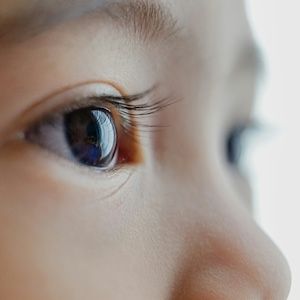News
Article
Amblyopia Care Disparities Persist Amid Widespread Photoscreener Adoption
Author(s):
Vision screening rates for amblyopia showed substantial increase after photoscreening expansion, but patients who were Asian, Black, and Hispanic were less likely to be screened.
Credit: Bady Abbas/Unsplash

Widespread adoption of photoscreeners was associated with a rise in the overall rates of vision screening for amblyopia among 3-year-old children, according to a new study.1
Among nearly 60,000 children in a large healthcare system in California, the screening rates increased from 5.7% in 2015 to 72.1% in 2022 after photoscreening expansion, while those belonging to diverse demographic groups were less likely to be screened.
“Given that rates of visual impairment in the US have been predicted to significantly increase by 2050, our study highlights that more needs to be done beyond mass photoscreening to decrease existing disparities,” wrote the investigative team, led by Cheryl D. Stults, PhD, Palo Alto Medical Foundation Research Institute, Center for Health Systems Research, Sutter Health.1
One or more eyes can be affected by amblyopia, a disease that can result in permanent vision loss if not properly identified and treated before age 7. A 2017 recommendation from the US Preventive Services Task Force (USPSTF) highlighted the need for vision screening at least once in all children aged 3 to 5 years to detect amblyopia.2 Despite these recommendations, the actual screening rate among children aged 3 is only 40%.
Stults and colleagues examined trends and variables linked to the screening, referral, or diagnosis of amblyopia before and after the expansion of photoscreening across a large heath system.1 The retrospective cohort study involved electronic health record (EHR) data and linked census data from children approximately 3 years old with a well child care visit between January 2015 and December 2022.
Between 2015 and 2017, 23,246 patients aged 3 had ≥1 well child care visit. Of this population, 11,206 (48.2%) were female, while 7659 (32.9%) were Asian. In comparison, during the 2018 - 2022 postimplementation period, 34,281 children (16,517 [48.2%] female; 11,506 [33.6%] Asian) were included for analysis.
Screening rates ranged from 5.7% (424 of 7505) in 2015 - 2017 and rose to 61.6% (4800 of 7792) to 72.1% (4578 of 6354) in 2018 - 2022. Referral rates also increased, from 17.0% (1279 of 7505) in 2015 to 23.6% (1836 of 7792) in 2018, with a downward trend to 15.7% (997 of 6354) in 2022. Diagnosis rates ranged from 2.7% (200 of 7505) in 2015, with a peak at 3.4% (263 of 7792) in 2018, and a decrease to 1.4% (88 of 6354) in 2022.
After multivariate regression analysis, Stults and colleagues found children who were Asian (adjusted odds ratio [aOR], 0.80 [95% CI, 0.72 - 0.88]), Black (aOR, 0.71 [95% CI, 0.53 - 0.96]), or Hispanic (aOR, 0.88 [95% CI, 0.80 - 0.97]) were less likely to be screened for amblyopia, compared with White patients.
Compared with White patients, Black patients had a comparable referral level, but Asian and Hispanic patients were more likely to be referred (Asian: aOR, 1.49 [95% CI, 1.36 - 1.62]; Black: aOR, 1.06 [95% CI, 0.74 - 1.53]; Hispanic: aOR, 1.32 [95% CI, 1.18 - 1.48]).
Investigators found Black patients had a comparable likelihood of amblyopia diagnosis to White patients, while Asian and Hispanic patients were more likely to be diagnosed with amblyopia (Asian: aOR, 1.29 [95% CI, 1.07 - 1.56]; Black: aOR, 0.45 [95% CI, 0.11 - 1.79]; Hispanic: aOR, 1.67 [95% CI, 1.33 - 2.11]).
An accompanying editorial from Marguerite C. Weinert, MD, of the department of ophthalmology and visual sciences at the University of Michigan, indicated that increasing access to screening will reduce disparities only if the care chain does not introduce bias.3
Weinert suggested more data are still needed to understand the greater implications of screening increases and to determine where the intervention will provide the greatest impact.
“This study serves as a reminder for future endeavors that an increased screening rate alone does not a successful intervention make, and continued in-depth analysis will be essential in pursuing equitable care for our pediatric patients,” she wrote.3
References
- Stults CD, Liang S, Wilcox J, Nyong’o OL. Amblyopia Care Trends Following Widespread Photoscreener Adoption. JAMA Ophthalmol. Published online February 01, 2024. doi:10.1001/jamaophthalmol.2023.6434
- Grossman DC, Curry SJ, Owens DK, et al; US Preventive Services Task Force. Vision screening in children aged 6 months to 5 years: US Preventive Services Task Force recommendation statement. JAMA. 2017;318(9):836-844. doi:10.1001/jama.2017.11260
- Weinert MC. Photoscreeners for Amblyopia—Access Does Not Equate to Equity. JAMA Ophthalmol. Published online February 01, 2024. doi:10.1001/jamaophthalmol.2023.6651





